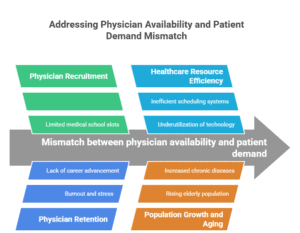On-Demand Outsourcing BPO Services for Healthcare Providers With 24/7 Coverage!
Save up to 70% on staffing costs!
Browse Specialty Staffing ServicesChallenges In Coordinating Physician And Patient Schedules

Coordinating physician and patient schedules is a complex balancing act that lies at the heart of healthcare efficiency. While technological advancements have improved appointment systems, healthcare facilities still face several persistent challenges that hinder effective scheduling. These barriers can impact access to care, physician productivity, and ultimately, hospital revenue.
1. Mismatch Between Physician Availability and Patient Demand

Physicians often have limited availability due to administrative duties, inpatient rounds, surgeries, and academic commitments. On the other hand, patients prefer flexible appointment times—often outside regular hours.
Key issues:
Limited time slots during peak demand periods
Long lead times for specialist appointments
Difficulty scheduling follow-ups within recommended timelines
This mismatch leads to underutilization or overbooking and affects both patient satisfaction and clinical outcomes.
2. Last-Minute Cancellations and No-Shows
Patient cancellations or no-shows disrupt tightly packed schedules. These last-minute changes waste valuable clinical time that could have been allocated to other patients.
Impacts:
Revenue loss from missed appointments
Decreased access for other patients
Reduced physician morale and inefficiency
Without robust waitlist or fill-in strategies, these gaps often go unfilled.
3. Complexity in Multi-Provider or Multi-Site Scheduling
In group practices or hospital systems with multiple locations and providers, aligning schedules becomes more difficult.
Challenges include:
Coordinating shared resources like exam rooms and diagnostic equipment
Managing cross-coverage among providers
Avoiding scheduling conflicts for patients needing multidisciplinary care
Without an integrated scheduling system, coordination errors are common.
4. Manual or Outdated Scheduling Systems
Many healthcare facilities still rely on manual methods or outdated digital systems that lack automation and interoperability.
Consequences:
Increased errors in double-booking or missed time blocks
Delays in updating appointment status
Difficulty managing complex appointment types (e.g., pre-op, telehealth, lab)
This results in inefficient workflows and burdens front-desk staff.
5. Limited Patient Self-Scheduling Options
Patients today expect digital access and convenience. When health systems don’t offer online scheduling or mobile options, call volumes rise, and friction increases.
Issues include:
Delays due to call center bottlenecks
Increased administrative overhead
Patient frustration and potential loss to competing providers
Empowering patients with real-time scheduling tools can reduce these barriers.
6. Inadequate Communication and Follow-Up Systems
Coordinating reschedules, confirming appointments, and issuing reminders is critical to keeping schedules intact.
If communication is lacking:
Patients may forget appointments
Last-minute changes may not be conveyed properly
Miscommunication leads to missed procedures or prep
Automated communication tools are essential to keeping patients and providers aligned.
What Did We Learn?
Coordinating physician and patient schedules is more than just a clerical task—it’s a strategic function that affects access, outcomes, and revenue. By addressing the common challenges of availability mismatches, system limitations, and communication gaps, healthcare providers can improve both efficiency and patient care delivery.
What people are asking?
1. Why is physician-patient scheduling so difficult?
Because it must align limited physician availability with patient preferences and care needs.
2. How do no-shows affect scheduling efficiency?
They waste valuable time slots and reduce access for other patients.
3. What happens when outdated scheduling systems are used?
It leads to errors, double bookings, and inefficient workflows.
4. Can patients help reduce scheduling issues?
Yes, offering self-scheduling and clear communication improves appointment reliability.
5. How does scheduling affect revenue?
Missed or poorly coordinated appointments result in revenue loss and lower provider productivity.
Disclaimer
For tailored support and professional services,
Please contact Staffingly, Inc. at (800) 489-5877
Email : support@staffingly.com.
About This Blog : This Blog is brought to you by Staffingly, Inc., a trusted name in healthcare outsourcing. The team of skilled healthcare specialists and content creators is dedicated to improving the quality and efficiency of healthcare services. The team passionate about sharing knowledge through insightful articles, blogs, and other educational resources.
 Book a Demo to Build Your Team Today!
Book a Demo to Build Your Team Today!

 Read Case Studies
Read Case Studies 


 Virtual Medical Assistants
Virtual Medical Assistants



